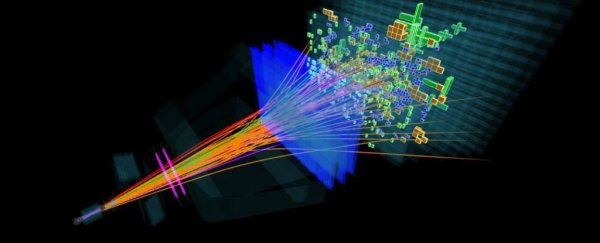A recent attempt to find a theoretical particle responsible for the Universe's early rapid expansion has come up empty handed, throwing a question mark over whether it really exists.
While there is still a low chance that the particle could be heavier than expected, or look a little different, physicists are preparing themselves for going back to the drawing board on one of the Universe's biggest mysteries.
Physicists from the Institute of Nuclear Physics at the Polish Academy of Sciences and the University of Zurich hunted for traces of a light form of a particle dubbed the inflaton in data collected during experiments using the Large Hadron Collider at CERN near Geneva in 2011 and 2012.
Much as its name suggests, inflatons are particles that, well, inflate space.
To be more precise, it helps to know why we're looking for them in the first place.
When we look up in the sky and measure the haze of microwave radiation, we find there's a background static that looks eerily the same no matter which way we look.
This background radiation, or cosmic microwave background, is the remnants of light that existed when the Universe was still just a few hundred thousand years old and not yet cool enough for particles to form.
As the Universe expanded, the radiation stretched into microwave lengths, which we can still see.
But given the scale of space, and the fact light from one side of the Universe hasn't yet had had time to make it to the other side, it seems odd that all of the light is spread out in such a similar way.
"When we look into the sky, the deep space fragments visible in one direction may be so distant from those visible in another direction that light has not yet had time to pass between them," researcher Marcin Chrzaszcz from the Polish Academy of Sciences explained.
"So nothing that has happened in one of these areas should affect the other. But wherever we look, the temperature of distant regions of the cosmos is almost identical! How could it have become so uniform?"
In 1981, a physicist by the name of Alan Guth suggested if the Universe grew rapidly for a short amount of time while still young and hot, the background radiation would still reflect that uniformity.
That period of rapid inflation would definitely explain what we see, but such a force requires a field to push, and all fields have particles to carry that information.
Enter the inflaton – a theoretical particle that would have shoved space to a gargantuan size in a fraction of a second before leaving the Universe expand far more gradually under its own cosmological constant.
Much like its famous cousin the Higgs boson, the inflaton (if it exists) would be too fleeting to be directly observable.
In fact, it was suggested at one point that the Higgs particle was in fact the inflaton in disguise.
Alas, it wasn't to be.
"For a long time a good candidate for the inflaton appeared to be the famous Higgs boson. But when in 2012 the Higgs was finally observed in the European LHC accelerator, it turned out to be too heavy," said Chrzaszcz.
If the Higgs particle had been responsible for making space inflate in a blink of an eye, its mass would have left its signature in the background radiation.
That meant the inflaton was probably Higgs-like, but with a smaller mass.
Particles that have very similar characteristics, such as tiny ghost-like neutrinos, can switch or "oscillate" into different forms called flavours. A Higgs particle oscillating into an inflaton would have given physicists two for the price of one when it was discovered in 2012.
To detect these blink-of-an-eye particles swapping forms, physicists would need to watch out for a specific sequence of particles as they decayed into one another following a collision in the Large Hadron Collider.
Specifically, a particle called a beauty meson – or B+ meson – would sometimes decay into a K+ meson called a kaon plus a Higgs particle. If the Higgs particle oscillated into an inflaton, it would then decay into a pair of elementary particles called a muon and an anti-muon.
Depending on how often this oscillation occurs, this pattern of B+ meson decays would vary.
"In our analysis we were looking for decays of up to 99 percent of the possible values of this parameter - and we found nothing. We can therefore say with great certainty that light inflaton simply does not exist", said Chrzaszcz.
Higgs could still be found oscillating into an inflaton in that remaining 1 percent of values, and future analyses on newer data will either spot it or rule it out.
There's also the possibility that it's a lot heavier than predicted, or it doesn't behave quite as physicists have thought.
Or, just maybe, it doesn't exist at all. Which would leave us back at square one, asking why when we look up at the sky does the Universe's backdrop look so incredibly smooth.
This research was published in Physical Review.
